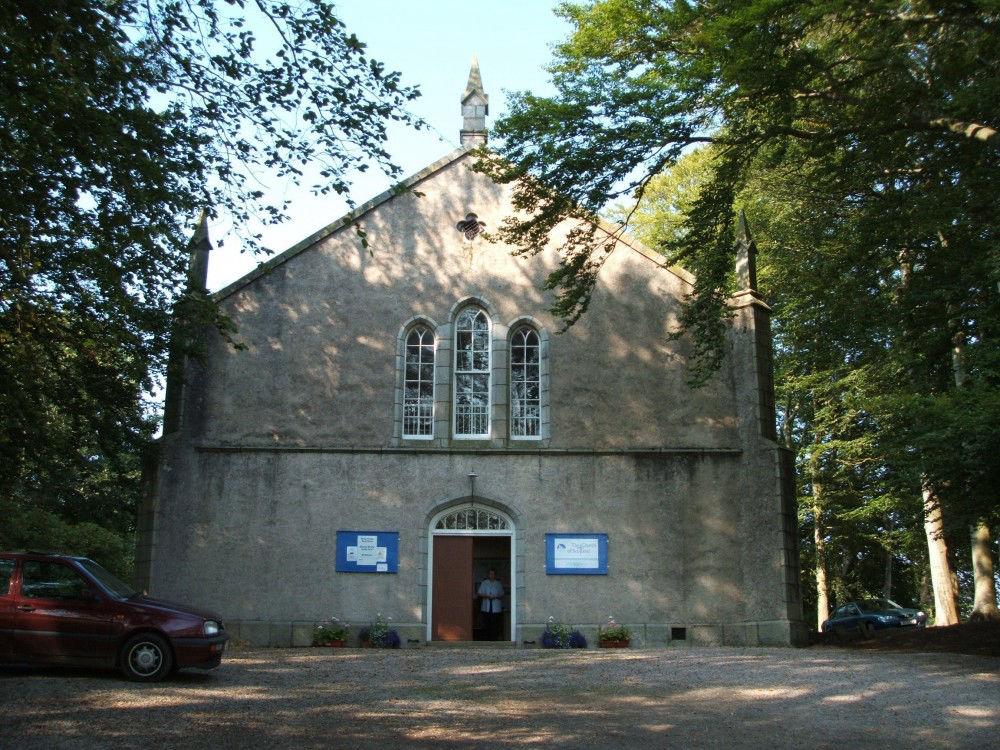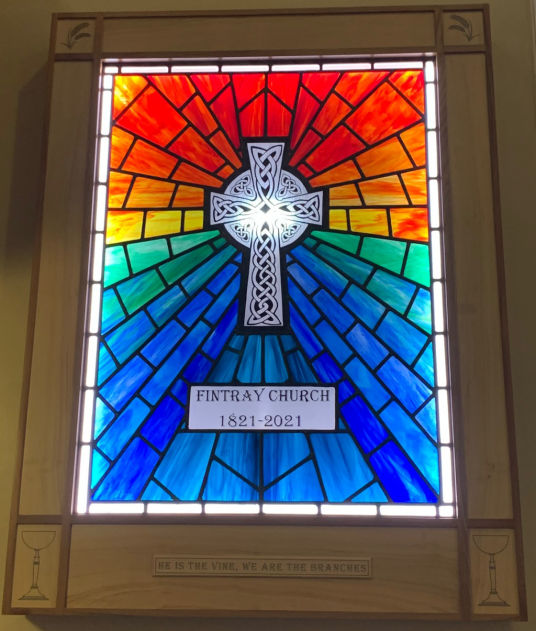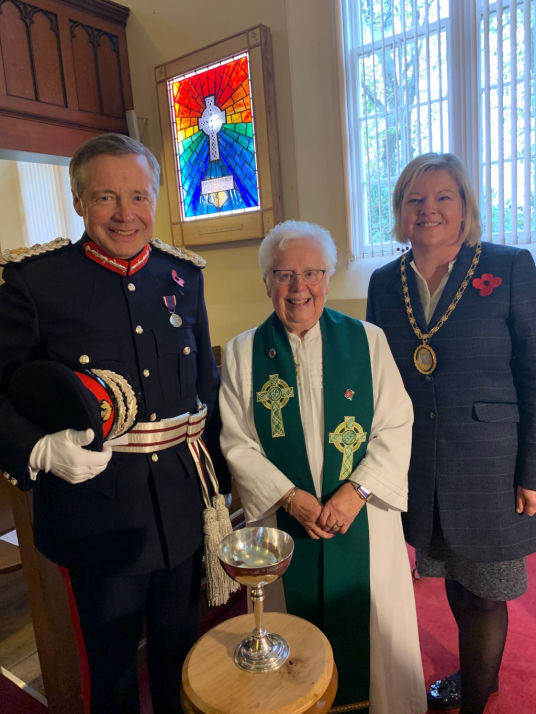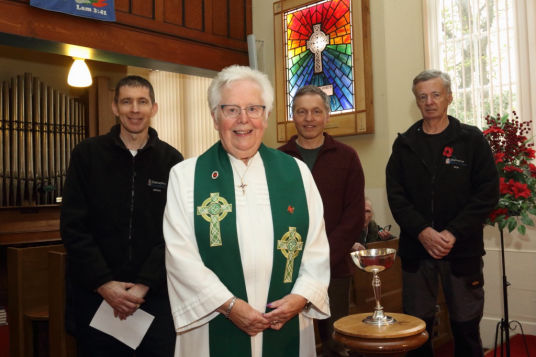CONTACT INFORMATION
You can contact us by phone or email.
-
- 01358 723055 (Interim Moderator direct)
- 01224 460056 (Answer Phone)
- fintraykkchurch@outlook.com
- © Copyright 2023 Fintray Kinellar Keithhall Parish Church - All Rights Reserved
| Year | Name | Notes |
|---|---|---|
| 1567 | Alexander Howie | Reader |
| 1567 | Thomas Fleming | Reader and Vicar |
| 1571 | Stephen Manners | Vicar |
| 1574 | Robert Wood | Reader at Fintray |
| 1574 | John White | Minister at Dyce, Skene, Kinellar and Fintray |
| 1576 | John Innes | |
| 1587 | Waiter Richardson | |
| 1580 | John Currie | Reader |
| 1583 | Thomas Gardyne | |
| 1594 | William Neilson | |
| l625 | Adam Barclay | |
| 1635 | Andrew Abercrombie M.A. | Covenanter |
| 1662 | George Meldrum | |
| 1681 | Alexander Forbes M.A. | |
| 1693 | Alexander Thomson | |
| 1699 | Robert Burnett M.A. | |
| 1702 | James Hutcheon M.A. | |
| 1712 | William Osborne | |
| 1732 | Patrick Gordon | |
| 1745 | Samuel Copland M.A. | |
| 1796 | John Leslie M.A. | |
| 1838 | William Leslie | |
| 1851 | James Gerard Young | |
| 1856 | William Ogilvie M.A. | |
| 1885 | John Catto M.A. | Presbytery Clerk 1890 -1903 |
| 1909 | James Andrew Crawford B.A. | |
| 1937 | William Cowie Farquharson M.A. | |
| 1947 | Peter Carmichael Millar O.B.E., D.D. | |
| 1961 | Thomas Crawford M.A. | |
| 1970 | Alasdair Bothwell Gordon LLB., B.D. | |
| 1976 | James Kincaid M.A., B.D. | |
| 1983 | Albert Caie L.Th. | |
| 1993 | Margaret J.Garden B.D. | |
| 2003 | Dolly Purnell B.D. | |
| 2007 | Dolly Purnell B.D. | |
| 2007 | Ellen Larson Davidson B.A., MDiv. | |
| 2007 | Sean Swindells | |
| 2020 | Sheila A Craggs | Gordon Presbytery Moderator 2019-2020 Fintray Kinellar Keithhall Interim Moderator |
Minister of the Parish 1970 – 1975

This is not intended to be either an exhaustive or a scholarly work and makes no such pretensions.
Since Rev. John Catto’s “Jottings on the Parish of Fintray” was printed in 1901 there has been nothing comparable published which is readily accessible. It is hoped that this modest little pamphlet may perhaps partially fill this gap.
It should be pointed out, however, that this pamphlet really deals mainly with the history of the church as distinct from the parish.
In former days it was often difficult to draw any such distinction, but nowadays the line is clearer. Much of the area assigned to the parish of Fintray is quite unrealistic and has long been so; furthermore, no one would pretend that the life of the average parish in Scotland really revolves round its church.
Accordingly, those who may wish to know Fintray’s secular history will find little in the following pages. Perhaps at some future date, someone will be able to fill this gap.
Like a great many churches in Scotland, Fintray Church has quite an interesting past. It is always pleasant and encouraging for present-day Christians to look back at the various ways in which God has moved His people in days gone by. Yet it is never enough just to look back with signs at the glory of yesteryear – for the church of God is set down in the 20th century and God’s commands and injunctions to men to be his disciples hold as strongly as ever.
Church buildings, however fine they may be will one day crumble into dust; traditions, however high they may be in their aspirations, will be forgotten – only He whom we worship remains, the same yesterday, today and for ever (Heb. 13: 8), the One who lives not in any temple made with hands (Heb. 9: 24) but in the living Person of Jesus Christ.
No one other than God Himself knows the future of the church at Fintray but His command is to follow in faith – and so, this modest little booklet is put out in the prayer that this may be the spirit in which our kirk will lead its life now and in the future.
Fintray Manse
February 1973 Alasdair G. Gordon
Christian witness in this parish without doubt goes back to the Celtic period of the church. An evangelist named Drostan, along with three followers – Colm, Medan and Fergus laboured to bring the Gospel to this North East part of Scotland.
In spite of evidence to the contrary contained in the Book of Deer, it would seem that this took place during the 5th century of the Christian era and so, before even the time of Columba. Drostan and his associates were almost certainly trained at the missionary school at Whithorn in Galloway, founded by Ninian in 397 AD and known as “Candida Casa”. Medan, it seems, founded a Christian Church at Cothal at the east end of what is now Fintray Parish, just across the river Don in the parish of Dyce if “Pitmeddan” as also there is an “Pitmeddan” in Udny parish and both these names give testimony to his labours.
The original church of Dyce was founded by Fergus and two churches – Dyce and Fintray respectively – faced one another across the Don. The present parish churches are quite a few miles apart.
Later in the history of Fintray, under Romanism, it seems that Medan was partially ousted as patron saint of the parish in favour of St.Giles.
After the time of Medan we really pass into a “dark” period of history. It seems virtually certain, however, that the parish bounds were marked out in the 12th century during the reign of David 1. They have changed very little since that time. In 1196 (?) David, Earl of Huntingdon, Lord of the Garioch and a grandson of David 1 founded the Benedictine Abbey of Lindores near Newburgh on the Fife bank of the Tay and endowed it generously. Among the endowments he granted was the “Church of Fintreth” which, in practice meant the whole parish. Provision had to be made, however, by the ecclesiastical authorities for the support, from the teinds of the parish, of a vicar to attend to the religious ordinances in Fintray.
Around this time too, it seems that a chapel was build and dedicated to St Giles in the region of what is now Chapelyards Croft. Before the reformation, most of the church lands were sold including Disblair, Milton, Logie, Blair and Foresterseat. The Barony jurisdiction of Fintray came into the hands of William Forbes of Craigievar in 1621.
It is of interest to note that the Minutes of the Presbytery of Aberdeen indicate that on 17th July 1601 a deputation visited the parish in connection with a petition from Rev. William Neilson, Minister at Fintray, for an increase of Glebe.
One of Fintray’s ministers in the 17th century was Rev. Andrew Abercrombie who was a Covenanter. His manse and crops were burned by Montrose in 1645 and Mr Abercrombie resigned his living before men of his convictions were ejected by Parliament in 1662. Unfortunately, he took the Session records with him and they were never recovered. The 17th century was a troubled century for Christendom in Scotland.
After Rev. James Hutcheson, minister at Newhills, was inducted to Fintray in 1701, it was decided to erect a new church. Since Celtic times the various church buildings and offices had been at Cothal but the ne church constructed in 1703 was built at Halltoun (Hatton) of Fintray on a small mound which was probably the site of the original mansion or “hall” from which Hatton takes its name.
The new church was a very plain building containing, probably two lofts – one for the laird and the other a “common loft”’
Mr Hutcheson died in 1712 and was succeeded by Rev. Osborne, son of the professor of Divinity at Marischal College. During his ministry, a new manse was built near the church at Hatton.
It is of interest to note that Patrick Copland LLD (1749 – 1822), professor of natural philosophy in Aberdeen, was a native of Fintray. His father was parish minister and also contributor to the “Old” Statistical Account.
The manse presently occupied was constructed 1851 – 55.
The church now in use was built in 1821 to the north of the 1703 building; a fragment of the latter still exists, now surrounded by the “old” churchyard. In 1830, a vault was built in the churchyard to store the bodies of deceased persons until they had putrefied beyond being of any use to the anatomists. Such vaults were by no means unusual at this time.
The parish of Fintray appears to have been untouched by the Disruption of 1843 and so, no Free Church was ever built. This is in contrast to most of the parishes in this area.
The parish area is recorded in the Old Statistical Account as 7388 acres and is said to be the “shape of an Irish Harp”. The third Statistical Account records the acreage as being 7270 acres. When the parish bounds were originally marked out, the river Don formed the southern boundary. In course of time, the Don changed its course slightly leaving two smallish areas of the parish on its south side. In October 1948 these two acres were formally ceded to the parishes of Dyce and Kinellar respectively. The present parish boundaries can easily be traced on an up-to-date Ordinance Survey map. Starting at a point just below Waterside, Kintore it follows an irregular line to a point just north of Greenlands, moving then east and south east to join the Newmill or Aultlather burn; it follows the line of the burn until it is joined by the Denburn tributary; it then follows the latter and crosses the Kinmuck road; thereafter it follows an irregular line again until it reaches its most northern point just about a mile north of Blair; it then follows an irregular line in a south easterly direction to meet the burn of Straloch; it follows the line of the burn until just south west of Newmachar village where it cuts across country in a south westerly direction to join the Red burn and the line of which it follows for a short distance only; it then follows another irregular line east, then south until it joins another small burn which flows into the Don at Heugh-head; thereafter, the Don itself forms the remaining boundaries. The neighbouring parishes to Fintray are Dyce, Kinellar, Kintore, Keith Hall and Newmachar. In 1970, Fintray was linked with Kinellar to form one pastoral charge over the two parishes.
The population is fairly widespread over Fintray parish. The main centre of population is at Hatton of Fintray which has a primary school, a post office and a shop. There are also small centres (1) at the hamlet of Disblair, which had a small school until recently, but no post office and (2) Cothal, which has a post office and shop.
The Main mansion house of the parish – Fintray house – was demolished some years ago and most of the former Fintray estate is now the property of an absentee landlord. Disblair house (formerly Disblair cottage) is a pleasant small mansion, the main wing being over 300 years old. Unfortunately, this part of the house was gutted by fire on 18th January, 1973.
The name “Fintray” is believed to mean “fair strand”.
The present church, build in 1821, is a substantial, handsome, if plain building with a high pulpit on the south wall and a gallery on three sides. In 1960, the church was modernised and electric power brough in for the first time.
At the same time, the organ was moved from its former position in front of the pulpit to its present location underneath the gallery on the east wall. A small vestry was taken out under the west gallery at the same time and a cupboard provided for the minister’s coat and gown; previously there was no vestry for the minister.
There is an externally rung bell dated 1821 on the west gable and the church is so designed that there is an entrance and gallery staircase on both east and west sides.
The pulpit is high and pleasing in appearance with an attractive (decorative) sounding board. Unfortunately, the stairs leading up to the pulpit are rather clumsily arranged.
There is a disused “laird’s pew” in the front central area of the gallery.
Like many churches built in the last century, Fintray Church is really too large for present needs.
The former Manse of Fintray, which now serves the linked charge, was constructed between 1851 and 1855 and was designed by William Smith, Aberdeen City Architect. Smith designed many fine buildings including Balmoral Castle, Trinity Hall, Gilcomston Free Church (now Gilcomston South), the former College of Domestic Science in King Street and the steeple of the St Nicholas Kirk.
The manse is a large irregular-shaped building, quite impressive by any judgement and well situated in its own grounds. By modern standards, the rooms are rather large yet the house is well proportioned and much more convenient to run than many houses of its vintage.
The outward appearance of both church and manse is spoiled by their stonework having been covered over, in typical Scottish manner, with drab grey harling.
The twin manse to that of Fintray may be seen at Methlick where a manse was built in 1861 on the same design.
Fintray Church possesses a very old silver cup inscribed “For the Holie Commvnion at Fintray Mr Adam Barclay Minister 1633”. This cup is the oldest know piece of Aberdeen silver (Hew Anderson 1614-1639), quite priceless and of considerable interest since various stories are attached to it. Some claim that the cup is actually older than its inscription and point out that there is a pre-Reformation recess in the north wall of the remains of the old church at Cothal into which the cup fits perfectly. This, of course, proves nothing apart from the fact that a cup of similar size could have been kept in this recess. There is another story that the cup was made from the silver head or image of St Medan which, in pre-Reformation days, was carried round the parish on St Medan’s day (14th November) or in times of drought or trouble. The full truth about the actual origin of the cup will probably never be known on this side of eternity!
There are also two very fine beaker-shaped silver cups still in use at Communion which were presented in 1699 by Sir John Forbes of Craigievar who bought them out of the vacant stipend of the parish. The handsome silver-plated Victorian wine flagon which appears on the Communion Sunday is of no special interest. Individual cups are now used at Communion, although their introduction is fairly recent.
On 27 July, 1901, a bazaar was held in the grounds of Fintray House to raise money to purchase an organ for the church. It was in connection with this bazaar that a little book “Jottings on the Parish of Fintray” was published and sold. Though anonymous, it was the work of Rev. John Catto, minister of Fintray and Clerk to the Presbytery of Aberdeen.
As a result of the money-raising efforts, the present “Dunsanell” organ was purchased in 1901. It is a single manual extension instrument with three ranks of pipes and it still gives excellent service in leading congregational praise. Originally, it was manually blown but an electric motor was fitted in 1960 and the instrument was overhauled and cleaned.
The church possesses quite a large number of Communion tokens which represent three centuries:-
17th century – very small rectangular lead tokens inscribes “M A F”. These initials stand for “Mr Alexander Forbes” who was inducted as minister in 1681.
18th century – square lead tokens bearing the inscription “Fintray 1761”.
19th century - plain oval tokens inscribed “Fintray Parish Church 1854” with an indication as to which Table the communicant should attend. On the back are inscribed the words “This do in remembrance of me Luke 22: 19” and “But let a man examine himself 1 Cor. 11: 28”.
The handsome CommunionTable has a small plate bearing the following inscription: - “Presented to Oldmachar United Free Church by Robert Clark to the Glory of God and in memory of his wife Mary Helen Forsyth whoc died on 8th November 1927 and of their son George Clark killed in action at Hooge on 25th September 1915. Jesus said ‘I am the Resurrection and the Life’”.
Through the process of union and readjustment, the church which originally held theTable was closed. The Table came into possession of the Kirk Session of St Machar’s Cathedral who, in turn, kindly presented it to Fintray church on 1st May 1960. A suitable inscription to this effect was added just below the original.
It is of interest to note, just in passing, that the Oldmachar Church had as its minister from 1848 – 60, Rev. Dr. Alfred Edersheim, the famous Biblical scholar and writer whose works are still widely read and greatly valued.
The three oak chairs behind the Table were presented in 1960 by past and present members of the Convener Court of the Seven Incorporated Trades of Abedeen in recognition of the services of Rev. Dr. P. C. Millar, a former minister of Fintray, who was their patron from 1948-60.
The handsome oak font now in use in the church was the generous gift of James T. Ogston Esq. of Fintray Mills, who is an elder in the congregation.
In a frame on the west wall of the sanctuary may be seen a brass plate which bears the following inscription:- “This Bible was presented to Rev. John Leslie, Minister of Fintray and to the Elders of the Kirk Session and their Successors in office by Thos. Morison of Elsick & Disblair for the Church build this year. Disblair Cottage 1st October 1821.
This Thomas Morison would probably be a son of James Morison of Elsick the provost of Aberdeen who married Isabella Dyce, the daughter of James Dyce of Disblair.
How the plate comes to be in its present position is a remarkable story – and a partly unsolved mystery (the plate was actually found in 1926). Shortly after the first World War, it was found lying on the ground in a building site in Dyce by Mr John Forbes who was then an apprentice painter. It remained in Mr Forbes’ possession until 1971. The present minister got to know of its existence through Mr James Duncan, an elder in John Knox (Gerrard Street) church. When Mr. Forbes was approached, he readily agreed to present the plate to the church in October 1971 to mark the 150th anniversary of the church building. So, 150 years almost to the day this plate was presented to the church for the second time in its existence. The Bible to which it was attached seems to have disappeared and how the plate ever found its way to Dyce is a mystery which may never be solved.
At the October Communion of 1971, the plate and its story were indicated to the congregation and a special prayer of thanksgiving was offered to mark the 150th anniversary of the building of the present church.

"Holie Communion, Fintray 1633 Revd Adam Barclay, Minister"

Created by Distinctive Glass of Hatton of Fintray, Lethenty Cabinetmakers of Kinellar and active involvement of the children of Hatton of Fintray Primary School

Lord Lieutenant Sandy Manson, Reverend Sheila Craggs, Aberdeenshire Provost Judy White

Brian Innes (Distinctive Stained Glass, Hatton of Fintray), Graham Winram (Lethenty Cabinetmakers, Kinellar), Ron Innes (Distinctive Stained Glass, Hatton of Fintray)
You can contact us by phone or email.